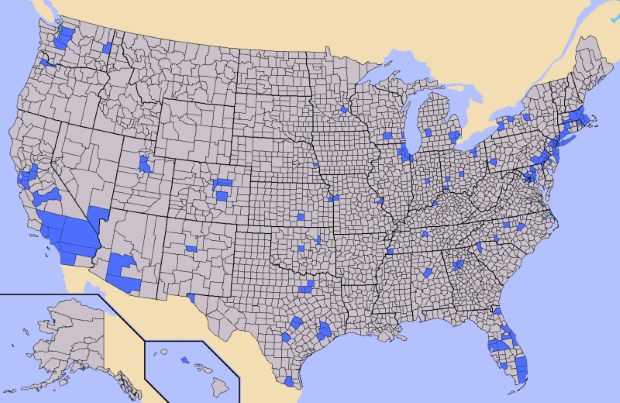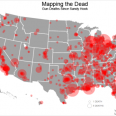| Online: | |
| Visits: | |
| Stories: |
Map: Where You Don’t Want to Be When It Hits the Fan
When it hits the fan America’s population centers will explode in violence, looting, and total breakdown of law and order.
It’s a theory put forth by numerous survival and relocation specialists, and one that makes complete sense if you consider what happens in a truly serious collapse-like scenario.
Survival Blog founder James Rawles calls them the golden horde:
Because of the urbanization of the U.S. population, if the entire eastern or western power grid goes down for more than a week, the cities will rapidly become unlivable. I foresee that there will be an almost unstoppable chain of events:
Power -> water -> food distribution -> law and order -> arson fires -> full scale looting
In his recent documentary Strategic Relocation, retreat expert Joel Skousen echoes Rawles’ warnings:
The number one threat that I concentrate on. It’s not terrorism, it’s not natural disaster, it’s not even government or war.
The major threat is population density.
Because every crisis that threatens, even a local crisis, can turn exponential because of close proximity to people who cannot help themselves. Even good people panic in a crisis…
So, where should you be when it happens?
To find the answer, let’s consider where we shouldn’t be.
Recent U.S. census data indicates that out of the 3000 counties in the United States, fully 50% of the population lives in just 146.
If you want to have any chance of surviving a wide-spread catastrophic event by avoiding the hordes that will be searching for critical resources in its aftermath, then check out the following map to get a visual reference of the areas you want to stay away from.
When considering your retreat locations or emergency evacuation routes, be familiar with the population densities of the area you’re headed to, as well as those counties in your immediate vicinity.
In his book Patriots, James Rawles specifically points out that Highway 80, running through California, will be one of the busiest evacuation routes in the country as millions of people pour out of major cities to flee disaster or in search of food.
So, no matter where you are located, consider your proximity to high traffic thoroughfares going in and out of the city. During Hurricane Rita, which hit Houston several years ago, every major pipeline out of the city was jammed for hundreds of miles. Interstate 45 from Houston to Dallas was bumper to bumper traffic. Normally a 4 hour trip, those who didn’t evacuate in time were stuck on the highway without food, gas, sanitation, or potable water for upwards of 15 hours.
This is why Joel Skousen suggests that those looking for strategic retreat locations or homes outside of major cities consider highway proximity. Be at least 5 – 7 miles away from any major thoroughfare, which is generally outside the range people want to venture off familiar roads, and far enough away to make any ‘walkers’ too tired to attempt the trip without ample clean water and food.
If you have no choice but to be in a major metro area during a serious emergency situation, consider strategies that can help you remain sustainable in the city even in the midst of panic.
http://www.bioprepper.com/2015/02/04/map-dont-want-hits-fan/
Other useful resources:
Survival MD (Best Post SHTF Medical Survival Guide Ever)
Blackout USA (EMP survival and preparedness guide)
Backyard Innovator (All Year Round Source Of Fresh Meat,Vegetables And Clean Drinking Water)
Conquering the coming collapse (Financial advice and preparedness )
Liberty Generator (Easy DIY to build your own off-grid free energy device)
Backyard Liberty (Easy and cheap DIY Aquaponic system to grow your organic and living food bank)
Bullet Proof Home (A Prepper’s Guide in Safeguarding a Home )
Family Self Defense (Best Self Defense Strategies For You And Your Family)
Sold Out After Crisis (Best 37 Items To Hoard For A Long Term Crisis)
You may also like …















monsanto will protect you! eat eat! Hear me roar!! oink oink woof woof.
???
You should share your drugs with me moo cow. I’m not talking the Rbgh stuff. I’m talking the good stuff like the coke.
The scenario being described in this article does not go into the possibility that due to HIGH TECH ASSYMETRI WARFARE, which results in pestilence and famine, and the sophistication and varieties of the technologies to kill large numbers of people, there may be few survivors in high density areas, especially along the coastlands where there are millions of people now living. There are all kinds of high tech conventional, and “unconventional”, assymetric weapons being used right now, but few undestand the complexities of the technologies involved. I think this is why the government is pushing mandatory vaccinations, especially in CA, as part of Project BioShield (.http://lifeboat.com/ex/bio.shield), which few people on this website and others like it rarely discuss. The ongoing severe drought in CA, NV, and AZ, which I think is being made to happen, is already causing many people to leave those areas, though you won’t read, see, or hear much about this. Many city governments in those states are no longer bringing in enough tax revenue to support them. San Bernadino is one example. Water is the number one resource people need in order to survive. Without it people die in just a few days. If the drought continues to worsen in those areas, there will be, and there is predicted to be, mass migrations of people out of those areas. Where I live, there is a major interstate highway that goes through the town. Have seen numerous vehicles from out of states that are thousands of miles from here. Are they just tourists, or are they from areas that have been affected by recent “events” or “disasters”?
“avoiding the hordes that will be searching for critical resources” First rule, don’t be one. In any disaster, you are going nowhere. Shelter-in-place with preparation is your only option. My contribution to sustainable sheltering: GordonRocketCompany.com Order now or make your own. Clean, safe, high-efficiency heat and eat for preparedness. Fun on beach, camping or patio until then. David
$400 for your rocket stove? Seriously? There’s practically nothing to it. I could buy a full blown pellet wood stove at Lowe’s for about 600.
I could buy smokeless coal and use a tin and a match still cheaper
One MAD Cow

